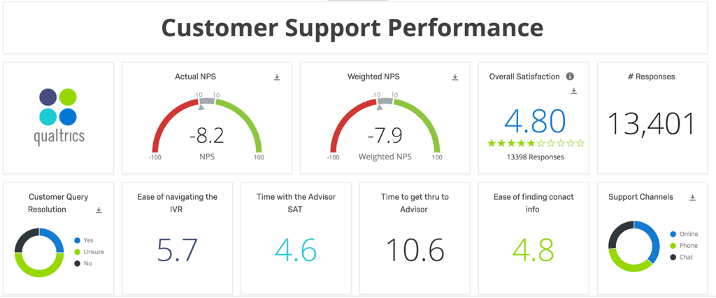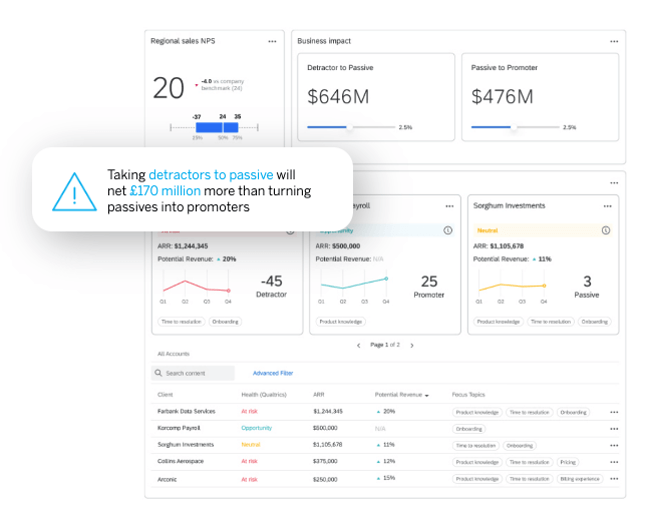What is quality assurance?
Quality assurance (often abbreviated to QA) is the act of ensuring your various services are meeting (or exceeding) the standards of quality you’ve set out for them. This often includes monitoring and evaluating customer service calls, chats, and other interactions between your agents and your customers.
Quality assurance assessment ensures the day-to-day compliance of your team with legal and company regulations, but it’s also how you can guarantee that your team is offering what you consider to be a “quality” service in a way that’s standardised, measurable, and replicable.
You can think of quality assurance (and quality management) as a formalised way to guarantee strong customer retention through high-quality, consistent service provision
Turn customers into fans with the Qualtrics CX platform
Difference between quality control (QC) and quality assurance (QA)
Confused about the difference between QA, QM, and QC? In short, QA and QC are tactical, tick-box evaluations of processes, while quality management describes the bigger, more overarching risk assessment themes, trends, and strategies within an organisation.
And while quality assurance is generally focused on how processes are performed, or how service is delivered – for example, agent performance in call centres – quality control focuses on the prevention of mistakes. Usually, that’s through the creation and ongoing evaluation of QC policies.
Usually, your quality assurance function will have a “checklist” of standards to mark services against. In a call centre, for example, that would be key performance indicators like script compliance and customer success.
Quality control, on the other hand, is focused on the evaluation and management of quality for products – usually during the development process.
It focuses on correcting issues, such as product defects, and is concerned with carrying out a quality audit and taking corrective action, rather than deciding what checks need to be made.
Quality management sits over the top of both, analysing how quality standards can be formalised and maintained.
What is call centre quality assurance?
In this article we’re going to focus on call centre quality assurance in particular – the what, why, and how. In that setting, quality assurance refers to the act of monitoring every customer interaction your contact centre has, and using a defined process to improve the customer experience.
In simple terms, that means call monitoring, call scoring, and using software that can track and determine qualitative values like sentiment to help guide and improve your call centre (and in particular your agents’) performance.
But quality assurance in call centres can also have operational benefits, as well as customer experience ones. For instance, your call centre quality assurance program might produce data highlighting the fact that staffing needs to be ramped up or wound down at certain times, or that customer demand peaks at specific times of the day, month, or year.
In general, call centre quality assurance is all about tightening the various nuts and bolts of your contact centre, fine-tuning agent performance, and delivering more positive customer interactions.
Call centre quality assurance: Why should businesses care?
The surface-level benefits of implementing a call centre quality assurance program should be obvious, given that the aim of the process is to improve the customer experience. But what might surprise you is just how necessary that improvement is.
In our recent 2022 Consumer Trends Report, we found that some 9.5% of your business’ revenue could be at risk due to bad experiences, while consumers are 3.5x more likely to purchase from a business after a positive customer experience.
Supercharge your CX
While the overall customer journey is a complex map of touchpoints, your call centre is a key part of ensuring that customer interactions are positive. With our research showing that 8/10 people believe customer experience needs to be improved, the need to tighten up your contact centre’s operations should only become more and more evident a priority.
In fact, there are a couple of key ways in which putting a greater focus on customer satisfaction and call centre quality monitoring can yield operational results:
Boosting agent effectiveness in call centres
As part of the quality assurance process, you’ll learn who your best performers are, who needs extra training, and how well people are sticking to the script. Alongside this, you’ll be able to implement gamification and incentives that boost service ops efficiency and improve your agent’s satisfaction. Satisfaction in the workplace is so important because it helps to reduce agent turnover, and in doing so keeps costs down and service level higher.
Ensuring customer satisfaction and reducing churn
Monitoring what’s working alongside what’s not a part of your call centre QA will help you turn every single call into an opportunity to make a positive impact on your customer’s overall journey. And if a customer interaction is a positive one, they’re 60% more likely to make repeat purchases.

Call centre quality assurance methods
The methods for carrying out call centre quality assurance fall into two categories, depending on whether or not you’re using software to do most of the QA and quality management work for you.
Manual call centre QA with sampling
If your call centre’s quality assurance program is being done manually, it’s often impossible to vet and monitor every call handled by every agent. Instead, you’ll likely take a representative sample at various points and track those against your chosen goals. The goal here would be to look for coachable moments and find areas where agents can improve. You might also rely on post-call surveys that solicit feedback from customers.
Automated (unsampled) call centre QA
The faster, more modern, and transparent way to handle call centre quality assurance is to use a quality management software suite. A software solution with AI and machine learning built in can measure performance in a consistent and unbiased way across every single interaction, without relying on samples.
As well as being able to track metrics like script compliance, tools with natural language processing can detect and track sentiment, effort, and emotion, making it easier to find trends and opportunities for improvement across every interaction.
How to improve call centre performance
Looking to boost customer satisfaction through stronger call centre QA, quality management, and agent performance? Here’s how to build out a robust call centre QA framework…
Integrate quality assurance insights into your strategy
Quality assurance is often seen as being a box-ticking exercise, but it can be so much more when you view this process through the lens of strategic management. When quality assurance software flags that there is an issue with how a call was handled, this typically affects only that specific customer service agent’s score on their performance. However, QA specialists are uniquely able to get a view of where coaching sessions might benefit the whole team – and this can become part of your overall strategy.
It’s not only your customer service team that can benefit from insights gathered during your QA process. Your product teams, sales teams and more can see more clearly if there’s a gap between your customer experience and your brand’s expectations.
Outline your goals
It’s always beneficial to begin any new initiative by gathering key stakeholders together and establishing what your goals are. In this case, it may be that you want to embark on quality monitoring to help change key performance indicators like customer churn. Or it might be more important that you can highlight and reward top performers. Whatever the case, the call centre QA framework you put in place should be built around these core aims.
Monitor regularly
Call centre performance is fluid – it changes all the time, with every new customer interaction acting as a new piece of data to learn from. So it’s important not to view call centre QA as a one-and-done task. Instead, monitoring should happen as regularly and thoroughly as possible.
Automate the call centre QA process
To that end, your QA efforts will be greatly improved by automating the task with quality management software. Automated scoring, real-time analytics, and unbiased benchmarking are all strong benefits of using a dedicated software solution instead of manual monitoring.
Track sentiment
As well as helping you monitor things at scale and in real-time, automated QA solutions also allow for AI-powered natural language processing. This is by far the fastest and most efficient way to scour calls and other customer interactions for sentiment, effort, and emotion – which is the best way to understand what your customers are feeling, and where pain points are causing friction on their buying journey.
Gamify things and reward agents
Call centre QA isn’t just about improving customer satisfaction: it’s also a great way for call centres to identify their best-performing agents, and highlight those that need coaching sessions.
Being transparent with call scoring will help agents understand what’s working and what’s not, ultimately empowering them to self-improve. But the information you learn from QA and performance management should also be used to introduce incentivisation that can reward agents when they’re doing well.

Understand the bigger picture
Call centres, contact centres, social media, email, and chatbots… Call centres themselves are just one part of a much bigger puzzle. In today’s omnichannel business environment, customers are interacting with (and about) your brand in nearly endless ways across a wide range of touchpoints.
That can be a challenge to keep on top of, but the best way to overcome that challenge is with a technology solution that incorporates call centre quality assurance as just one part of the CX puzzle.
Using AI to monitor customer satisfaction and sentiment during contact centre calls is great, but that active listening and processing power should also be pointed at social media platforms, third-party review sites, chatbots, and emails alike. It’s only by getting a clear view of customer interactions across mediums that you’ll be able to make decisive, beneficial changes to the overall customer experience.
Call centre quality management, the easy way
Call centres are living and breathing, with changes and challenges occurring on an hourly basis. That inherently makes performing robust call centre QA and quality management a difficult prospect. It needn’t be a daunting process, though. In fact, the right technology can make your QA processes much more rigorous while also massively reducing the workload.
Qualtrics’ CX platform has been designed to enable exactly that. It combines call centre QA, agent training, customer outreach, and journey tracking – all powered by market-leading predictive intelligence that works to listen to your customers wherever and whenever they talk.
Our platform is then able to take all that real-time, always-on data and make sense of it for you, providing agents, account managers, and digital marketers with simple, actionable insights that can help boost customer satisfaction, agent retention, and – ultimately – revenue.
Turn customers into fans with the Qualtrics CX platform